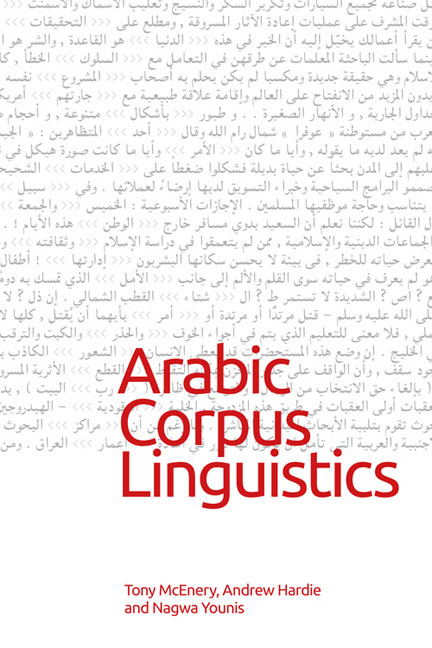Book contents
- Frontmatter
- Contents
- Notes on Contributors
- 1 Introducing Arabic Corpus Linguistics
- 2 Under the Hood of arabiCorpus
- 3 Tunisian Arabic Corpus: Creating a Written Corpus of an ‘Unwritten’ Language
- 4 Accessible Corpus Annotation for Arabic
- 5 The Leeds Arabic Discourse Treebank: Guidelines for Annotating Discourse Connectives and Relations
- 6 Using the Web to Model Modern and Qurʾanic Arabic
- 7 Semantic Prosody as a Tool for Translating Prepositions in the Holy Qurʾan: A Corpus-Based Analysis
- 8 A Relational Approach to Modern Literary Arabic Conditional Clauses
- 9 Quantitative Approaches to Analysing come Constructions in Modern Standard Arabic
- 10 Approaching Text Typology through Cluster Analysis in Arabic
- Appendix: Arabic Transliteration Systems Used in This Book
- Index
10 - Approaching Text Typology through Cluster Analysis in Arabic
Published online by Cambridge University Press: 11 November 2020
- Frontmatter
- Contents
- Notes on Contributors
- 1 Introducing Arabic Corpus Linguistics
- 2 Under the Hood of arabiCorpus
- 3 Tunisian Arabic Corpus: Creating a Written Corpus of an ‘Unwritten’ Language
- 4 Accessible Corpus Annotation for Arabic
- 5 The Leeds Arabic Discourse Treebank: Guidelines for Annotating Discourse Connectives and Relations
- 6 Using the Web to Model Modern and Qurʾanic Arabic
- 7 Semantic Prosody as a Tool for Translating Prepositions in the Holy Qurʾan: A Corpus-Based Analysis
- 8 A Relational Approach to Modern Literary Arabic Conditional Clauses
- 9 Quantitative Approaches to Analysing come Constructions in Modern Standard Arabic
- 10 Approaching Text Typology through Cluster Analysis in Arabic
- Appendix: Arabic Transliteration Systems Used in This Book
- Index
Summary
Background: classifying texts on external and internal criteria
Although there exist many different approaches to the classification of texts into categories, most such work can be considered functional in orientation, being based on features external to the text such as its purpose, the discourse context, and the medium of communication. Kinneavy (1971), for instance, provides a comprehensive framework for establishing text categories, using elements of the communicative situation to develop a philosophy of the aims of discourse. Those elements are: the person encoding a message; the signal (language) through which the message is communicated; the reality to which the message refers; and the receiver of the message (Kinneavy 1971: 19). According to Kinneavy, one of these elements could be the primary focus that distinguishes a specific discourse in a given situation, while the other elements have a subordinate role. On this basis, Kinneavy (1971) identifies four types of discourse: reference, persuasive, literary, and expressive.
De Beaugrande and Dressler (1981: 184) also use text-external features to classify texts into categories, stating that the main feature defining a text-type is the communicative function of the text. Accordingly, they identify eight text-types: descriptive, narrative, argumentative, literary, poetic, scientific, didactic, and conversational texts. Because of the diversity of text functions, de Beaugrande and Dressler (1981: 186) conclude that this typology does not result in absolutely distinct text-types; rather, some texts may overlap, moving from one text-type to another.
Werlich (1982) presents a typology which draws heavily on the description of text categories proposed by de Beaugrande and Dressler. On the basis of contextual factors such as persons with intentions, reactions, presuppositions, and status; objects; relations, and so on, Werlich establishes five text-types: description, narration, exposition, argumentation, and instruction. On similar lines, Hatim and Mason (1990) base their typology on what they call dominant contextual focus, identifying three text-types: argumentative, expository, and instructional – conflating three of Werlich's categories (description, narration, and exposition) into one, exposition.
- Type
- Chapter
- Information
- Arabic Corpus Linguistics , pp. 201 - 228Publisher: Edinburgh University PressPrint publication year: 2018



